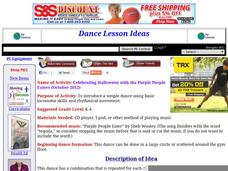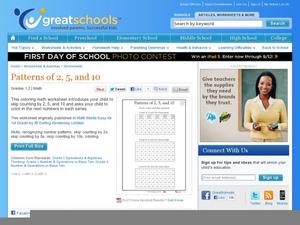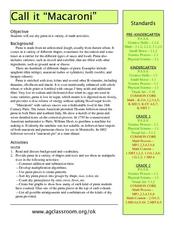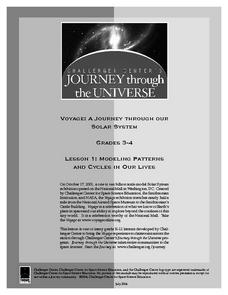Sargent Art
Destination Art: Paper Mola Collage
The Kuna Indians hail from the San Blas Island near Panama. Learners will investigate their culture by creating paper mola collages, just like the ones created by the indigenous Panamanians. They'll focus on understanding the symbolism...
Curated OER
A Different Point of View
Elementary schoolers utilize a pattern worksheet embedded in this plan to work on a deeper understanding of geometric concepts like symmetry and congruency. Since geometry is such a visual form of mathematics, this lesson plan should fit...
PBS
Patterns to the Rescue!
Track down the Cyberchase episode that this lesson is associated with. Using a worksheet that is embedded in the plan, learners must find the next two numbers and shapes (a double pattern). Once these have been discovered, pupils try...
Curated OER
Celebrating Halloween With the Purple People Eaters
Get youngsters moving by teaching them some basic dance moves. This dance can be done in a circle, a line, or scattered around the gym. There are four movement combinations that are taught to the song "Purple People Eater" by Sheb...
Curated OER
Using Rhythm to Teach Patterns and Directions
Introduce young learners to line dancing. Here are some simple movement patterns to teach them. First teach, repeat, and repeat again without music. Then when they have a pretty good grasp of the movement patterns, add music and practice...
Curated OER
Multiplies of 9 #2
Reinforce the multiplying by nine as a number pattern. After completing sequences of the multiples of nine, pupils decipher a pattern in the entire nine times tables. Finally, they write down any patterns that they see. A great way to...
Curated OER
Venn Diagrams, Part 3
Can your first graders interpret Venn diagrams? Different sets of clues help pupils narrow down a specific number in different shapes. They determine odds and evens, greater than or less than, and what shape the number is in. A fun...
DK Publishing
Tracing Numbers, Part 2
Can your kindergartners write their numbers through 10? What about number patterns? This resource is a great way to get those training pencils moving! After tracing numbers 0 - 9, little writers continue three number patterns. Use this...
Curated OER
Line, Shape, Form, and Pattern
ArtsWork produces some very fine art lesson plans. This one is no exception! In it, learenrs experiment with line to develop skill in creating shapes and patterns. They also play around with shading to create forms. There are six...
DK Publishing
Sorting Fish By Pattern
Go fish! Preschoolers and kindergartners work on matching and patterns. This resource prompts little learners to match certain fish to the correct fisherman. They then count the types of fish and write the number in spaces provided....
Curated OER
Family Quilts Keep us Warm
Students explore families and culture. In this family and culture instructional activity, students discuss their families and their similarities and differences. Students read the book The Keeping Quilt by Patricia Polacco and create...
Curated OER
Chatty Cherry Stories
Young artists will respond to reading children's literature, by engaging in original storytelling and representing their own images through the visual arts. Then they orally describe details of people, places, and things in their stories...
Curated OER
Bugs Take Shape
Students investigate butterflies, moths, ladybugs and spiders looking at shapes, colors and patterns. They create a three dimensional bug using Crayola Model Magic, repeating patterns found in nature. They cut and shape the dough using...
Curated OER
Comma Practice Worksheet
Start by introducing your class to basic comma rules, and then give them this practice sheet. First, learners add commas where necessary, and then they write down which comma rule (or rules) used in each sentence. Great practice!
Curated OER
Patterns and Pentominoes
Students solve pentomino puzzles. In this problem solving lesson, students discuss how pentomino puzzles play into the plot of Chasing Vermeer by Blue Balliett and practice solving a pentomino puzzle on their own....
DK Publishing
Learning 2 - Write the Number
Help your kindergartners master the number two! After tracing the number three times and writing it out three times, little learners count groups of animals and write the correct number in a box (the number is always two). Finally, they...
Curated OER
It Just Keeps Going and Going...
Students explore patterns, identify patterns, and complete a variety of patterns. They view and discuss an online video and identify the different patterns from the film, then using a hundreds grid create an original pattern using their...
Curated OER
Patterns of 2, 5, and 10
Give your young counters practice with skip counting and colors as they shade in number grids by 2s, 5s, and 10s. The three grids reach 50, and the first one is partially completed to give scholars an example. They follow directions by...
Curated OER
Call it "Macaroni"
Who knew there were so many fun educational opportunities featuring pasta? Scholars read a brief informational text about the history of pasta (note that "macaroni" is spelled two different ways, so address this if kids are reading...
Curated OER
Ordering
Four sequences are missing some numbers; can your scholars fill them in? These aviation-themed number sequences require skip counting and counting backward. Beside each pattern learners can reference a jumbled set of numbers inside a...
Curated OER
Modeling Patterns and Cycles in Our Lives
Students explore how building a model can help them better understand the natural world. They identify common cycles or patterns in nature as well as examples of models in the classroom. After discussion, they choose a pattern or cycle...
Curated OER
Multiplication Sequences
In this math activity, students learn that a sequence is a set of numbers which follows a mathematical rule. Students look at math sequences and fill in the missing numbers and also explain in words what the pattern is. Some of the...
Curated OER
Identifying Patterns
What's the pattern? Youngsters examine four sets of sequential images to detect a pattern and continue it onto a fourth image. Ask them to verbalize what they noticed and how they continued this pattern. Consider extending the concept...
Curated OER
Patterns of 2s, 5s, and 10s
In order to connect the dots in three images youngsters skip count by twos, fives, and 10s. Encourage them to look for patterns as work, and consider giving out hundreds charts for guidance. They can also color these in once finished!

























